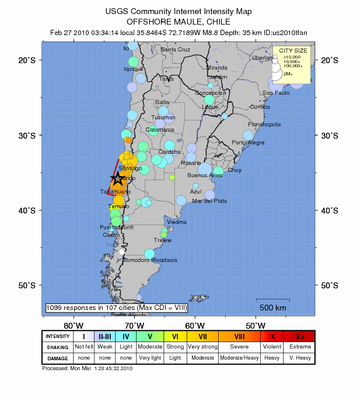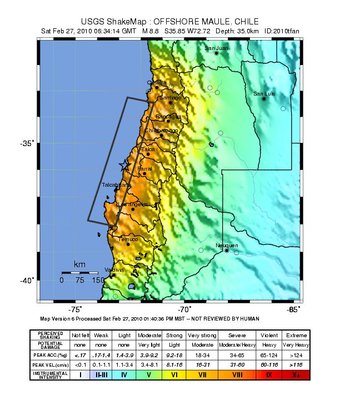
by Erin Wayman Thursday, January 5, 2012

Cities where citizens reported shaking from the Chile earthquake that struck Feb. 27. Blue indicates weak shaking and red indicates strong shaking. Circle size correlates to city size. U.S. Geological Survey

A USGS ShakeMap of the earthquake in Chile. Blue indicates weak shaking and red indicates strong shaking. U.S. Geological Survey
On Feb. 27, at 3:34 a.m. local time, a magnitude-8.8 earthquake struck offshore Maule, Chile, 325 kilometers southwest of the capital, Santiago. The quake released 500 times more energy than the magnitude-7.0 earthquake that hit Haiti on Jan. 12, according to the U.S. Geological Survey (USGS) — yet the smaller quake produced more extensive damage: The Haitian quake killed more than 200,000 people and left more than 1.2 million people homeless, whereas the Chilean quake killed at least 711 people and displaced 2 million people, according to the New York Times.
Geological differences as well as social factors explain why the smaller earthquake in Haiti was more deadly.
The Chilean earthquake occurred offshore at a depth of 35 kilometers on a 600-kilometer-long section of the subduction zone along the western South American coast, where the east-traveling Nazca Plate dips under the west-traveling South American Plate at an average rate of 80 millimeters per year, says Paul Caruso, a geophysicist at the USGS National Earthquake Information Center in Golden, Colo.
Subduction zones have produced many of the most notable earthquakes in recorded history, including the magnitude-9.0-plus earthquake that hit Sumatra in 2004 and the magnitude-9.5 earthquake that hit Chile in 1960. These quakes are also capable of producing giant tsunamis. After the quake hit Chile, the Pacific Tsunami Warning Center in Hawaii issued a tsunami warning for areas across the Pacific, including Australia, Hawaii, Indonesia and Japan (no major damage due to the tsunami has been reported outside of Chile).
The fact that this earthquake occurred in the ocean may be one reason it has — at least according to reports in the two days since the quake struck — caused less damage than the earthquake in Haiti, which occurred on land. Offshore earthquakes generate less ground shaking than onshore earthquakes because the intensity of ground shaking diminishes with distance, says Seth Stein, a seismologist at Northwestern University in Evanston, Ill. For example, he says, the magnitude-9.0-plus earthquake that rocked Sumatra in 2004 hardly did any damage to buildings; it was the enormous tsunami generated by the quake that caused the destruction. The same may be true for the Chilean earthquake: About half of the country’s casualties have been attributed to the tsunami that crashed against the Chilean coast.
In addition, the Chilean earthquake happened farther away from populated areas, Caruso adds. The Hatian earthquake, on the other hand, struck just 25 kilometers from the country’s capital, Port-au-Prince. The Haitian quake was also closer to the surface, with a depth of 13 kilometers compared to 25 kilometers for the Chilean earthquake, he says, so “people were farther away because the earthquake was deeper.”
Regardless of the earthquake’s size, Chile was also better prepared for an earthquake, Stein says. Because the country has a history of major seismic activity, Chile has stronger building codes than Haiti and its modern buildings are engineered to resist earthquakes, he says. Caruso agrees: The stricter building codes “probably saved thousands of lives.”
© 2008-2021. All rights reserved. Any copying, redistribution or retransmission of any of the contents of this service without the expressed written permission of the American Geosciences Institute is expressly prohibited. Click here for all copyright requests.